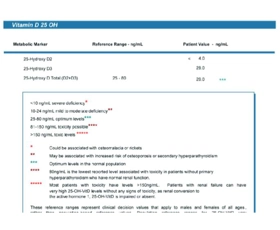维生素D测试 vitamin-D 25-hydroxyvitamin
gpl-0020
维生素D测试
关于测试
维生素D测试是血清或干燥血点分析进行定量即25-羟基D2和25-羟基维生素D3代谢物。代谢物25-羟基维生素D是维生素D在体内的主要循环形式和患者的真实维生素状态的最佳指标。维生素D的主要生物学功能是维持钙的正常血液水平和磷参与骨矿化。维生素D也影响超过2000个基因,包括那些负责调控细胞增殖,细胞分化,凋亡和血管生成的表达。维生素D的免疫调节作用是深远的,这证明了与维生素D缺乏相关的许多条件。
引入到维生素D
维生素D缺乏症已被链接到增加的风险为许多常见和严重的疾病,其中包括一些常见的癌症,糖尿病,心血管疾病和骨质疏松症。缺乏也是谁是完全母乳喂养,谁不接受维生素D的补充婴幼儿多见。成人谁拥有较深的皮肤(皮肤增加黑色素),或谁总是穿防晒或限制其户外活动,如闲居老年人的青睐,也容易出现维生素D的赤字。
研究表明,暴露于阳光下提高生产维生素D在皮肤和防止许多慢性疾病。季节性抑郁症也与维生素D的水平低的联系,特别是在冬季,当太阳光照射是在最低限度。维生素D也可以来自补充和饮食,但也有极少数的食物(富含脂肪的鱼类,鱼肝油,鸡蛋)天然含有维生素D的食物有几个自称与维生素D设防,但合成形式不作为强有力的和持续时间不长,在体内。
维生素D测试可有助于确定是否阳光曝晒是足够的,如果膳食维生素D是足够的,并评估吸收不良或肝脏疾病的可能性。
推荐用于下列病症和疾病
心血管疾病包括中风和高血压
癌症,尤其是前列腺癌
骨质疏松/骨软化症
低血钙水平
慢性骨/肌肉/关节疼痛
牙周疾病
I型糖尿病和II
炎性肠病
类风湿关节炎
其他自身免疫性疾病(多发性硬化)
慢性疲劳
抑郁和情绪障碍
精神分裂症
在老年人认知功能障碍
出生缺陷
维生素D的生物学功能
维生素D受体(VDR)是受维生素D,骨化三醇的活性形式激活的核激素受体。 VDR被大多数细胞在体内的每一个器官表达。超过2,000基因被激活VDR调控。
维生素D的主要作用是通过促进吸收,在肠和再吸收在肾脏,调节钙的血液水平和磷。钙和磷水平对骨矿化和生长以及用于预防低钙手足抽搐的重要。维生素D也是一个重要的免疫调节剂。它促进吞噬作用,抗肿瘤活性,并immunomodulary功能发挥中的自身免疫性疾病的作用。
维生素D缺乏人口
2000-2004年NHANES设于美国人口的维生素D营养状况的最新数据。大约9%的儿童人口,占760万美国儿童和青少年,25(OH)D缺乏和61%,相当于5080万美国儿童和青少年,25(OH)D不足。一般来说,年轻人有较高的维生素D水平比年长的人,男性有较高水平高于女性,和非西班牙裔白人有较高的水平比墨西哥裔美国人,谁又将有更高的水平比非西班牙裔黑人。根据人口基,1-9%有水平<11毫微克/毫升,8-36%有水平<20纳克/毫升,并且大部分(50-78%)的水平<30毫微克/毫升。
【适应症】用于维生素D测试
患者诊断患有任何的维生素D有关的疾病(癌症,糖尿病,高血压,心脏疾病,多发性硬化症,全身性红斑狼疮,抑郁症,阿尔茨海默氏症,帕金森氏,癫痫症,以及其他等)
骨质疏松患者或佝偻病
持续性和非特异性肌肉骨骼疼痛
抑郁症或精力不足的迹象
患者的胃肠道疾病和/或谁产生了胆囊切除术
老年人
超重的人有BMI>25
这是纯母乳喂养的婴儿或儿童没有一个良好的均衡饮食
个人每天服用维生素D的补充大于50微克(2,000国际单位)
个人驻留上述北纬42度(行约加利福尼亚州和波士顿的北部边境之间)
个体中等深色肤色或谁不经常收到20分钟阳光直射的每一天
分析物名单
25-羟维生素D 2和25-羟基维生素D3
标本要求
干血斑(DBS)的蛋白保护卡上的干血五个完整的圆是必需的。
Vitamin D Test
About the Test
The Vitamin D Test is a serum or dried blood spot analysis that quantitates 25-hydroxyvitamin D2 and 25-hydroxyvitamin D3 metabolites. The metabolite 25-hydroxyvitamin D is the major circulating form of Vitamin D in the body and the best indicator of a patient’s true vitamin status. The major biologic function of Vitamin D is to maintain the normal blood levels of calcium and phosphorus involved in bone mineralization. Vitamin D also influences expression of more than 2,000 genes, including those responsible for regulation of cellular proliferation, cell differentiation, apoptosis, and angiogenesis. The immune-modulating effects of Vitamin D are profound, as evidenced by the many conditions that are associated with Vitamin D deficiency.
Introduction to Vitamin D
Vitamin D deficiency has been linked to increased risk for many common and serious diseases, including some common cancers, diabetes, cardiovascular disease, and osteoporosis. Deficiency is also prevalent in infants who are solely breastfed and who do not receive Vitamin D supplementation. Adults of all ages who have darker skin (increased skin melanin) or who always wear sun protection or limit their outdoor activities, such as homebound elderly persons, are also prone to Vitamin D deficits.
Studies suggest that exposure to sunlight enhances the production of Vitamin D in the skin and prevents many chronic diseases. Seasonal depression is also linked with low levels of Vitamin D, especially during the winter months when sunlight exposure is at a minimum. Vitamin D can also come from supplementation and diet, but there are very few foods (fatty fish, fish liver oil, and eggs) that naturally contain Vitamin D. Several foods claim to be fortified with Vitamin D, but the synthetic form isn't as potent and doesn't last as long in the body.
The Vitamin D Test can help to determine if sun exposure is adequate, if dietary Vitamin D is sufficient, and to assess the likelihood of malabsorption or liver disease.
Recommended for the following disorders and diseases
- Cardiovascular disease including stroke & hypertension
- Cancer, especially prostate
- Osteoporosis/osteomalacia
- Low blood calcium levels
- Chronic bone/muscle/joint pain
- Periodontal disease
- Diabetes type I & II
- Inflammatory bowel diseases
- Rheumatoid arthritis
- Other autoimmune diseases (multiple sclerosis)
- Chronic fatigue
- Depression & mood disorders
- Schizophrenia
- Cognitive impairment in seniors
- Birth defects
Biological Functions of Vitamin D
The Vitamin D Receptor (VDR) is a nuclear hormone receptor that is activated by the active form of Vitamin D, calcitrol. VDR is expressed by most cells in every organ of the body. More than 2,000 genes are regulated by VDR activation.
The primary role of Vitamin D is to regulate blood levels of calcium and phosphorus by promoting absorption in the intestines and reabsorption in kidneys. Calcium and phosphorus levels are important for bone mineralization and growth as well as for the prevention of hypocalcemic tetany. Vitamin D is also an important immune regulator. It promotes phagocytosis, anti-tumor activity, and immunomodulary functions that play a role in autoimmune disease.
Vitamin D Deficiency By Population
The 2000-2004 NHANES provided the most recent data on the Vitamin D nutritional status of the U.S. population. Approximately 9 percent of the pediatric population, representing 7.6 million U.S. children and adolescents, were 25(OH)D deficient and 61 percent, representing 50.8 million U.S. children and adolescents, were 25(OH)D insufficient. Generally, younger people had higher Vitamin D levels than older people, males had higher levels than females, and non-Hispanic whites had higher levels than Mexican Americans, who in turn had higher levels than non-Hispanic blacks. Depending on the population group, 1-9 percent had levels <11 ng/mL , 8-36 percent had levels <20 ng/mL, and the majority (50-78 percent) had levels <30 ng/mL.
Indications For Vitamin D Testing
- Patients diagnosed with any of the Vitamin D related diseases (cancer, diabetes, hypertension, heart disease, multiple sclerosis, systemic lupus erythematosus, depression, Alzheimer's, Parkinson's, epilepsy, and other others)
- Patients with osteoporosis or rickets
- Persistent and nonspecific musculoskeletal pain
- Signs of depression or lack of energy
- Patients with gastrointestinal disease and/or who have had a cholecystectomy
- Elderly individuals
- Overweight individuals with a BMI >25
- Infants that are exclusively breastfed or children without a well-balanced diet
- Individuals taking Vitamin D supplementation greater than 50 mcg (2,000 IUs) per day
- Individuals that reside above 42 degrees north latitude (a line approximately between the northern border of California and Boston)
- Individuals with medium to dark complexions or who do not regularly receive 20 minutes of direct sunlight each day
Analyte List
- 25-hydroxyvitamin D2 and 25-hydroxyvitamin D3
Specimen Requirements
Dried Blood Spot (DBS): Five full circles of dried blood on the protein saver card is required.The elimination of a food will reduce the ability for our laboratory to detect antibodies (allergies) to that food.



